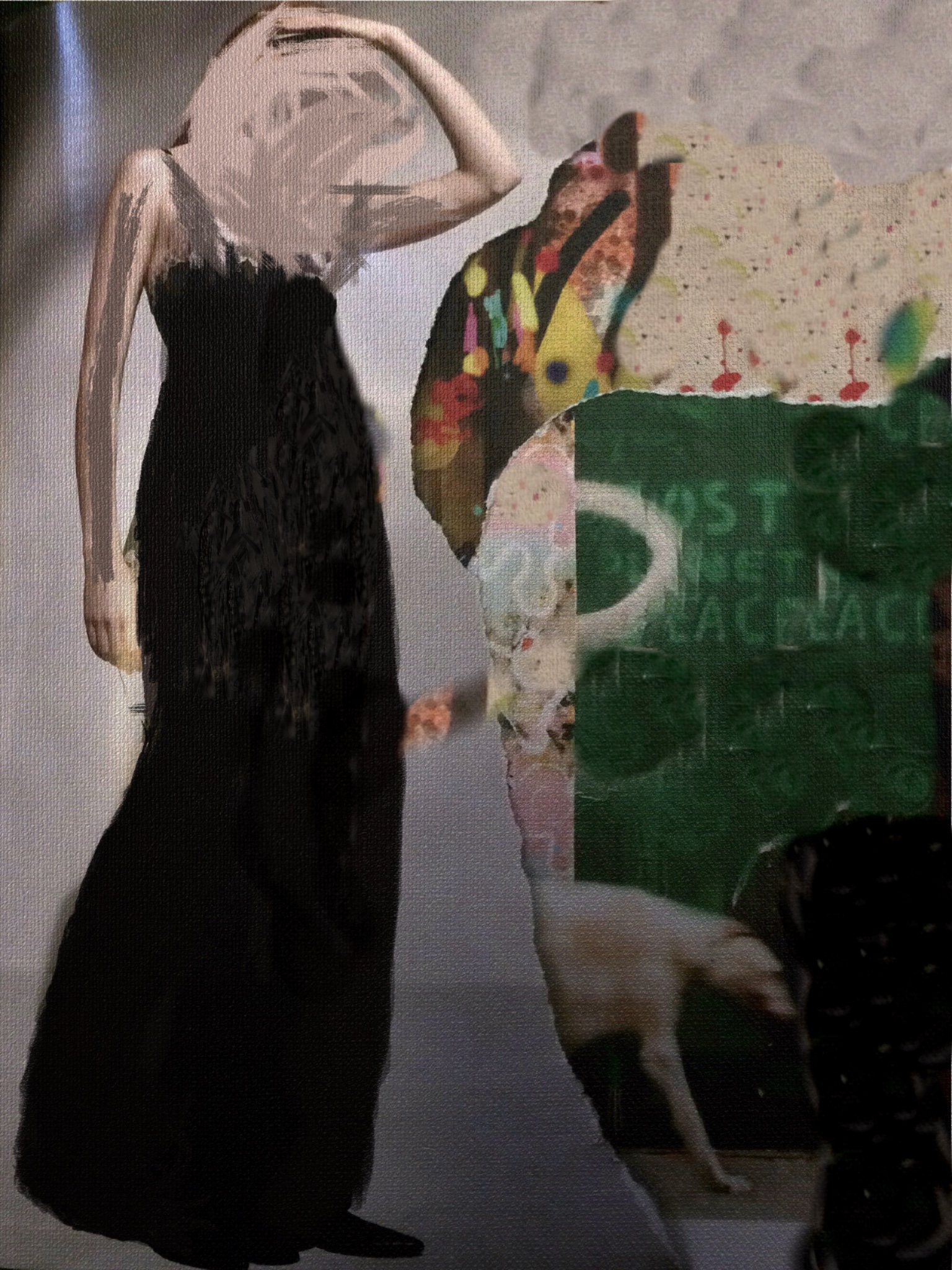

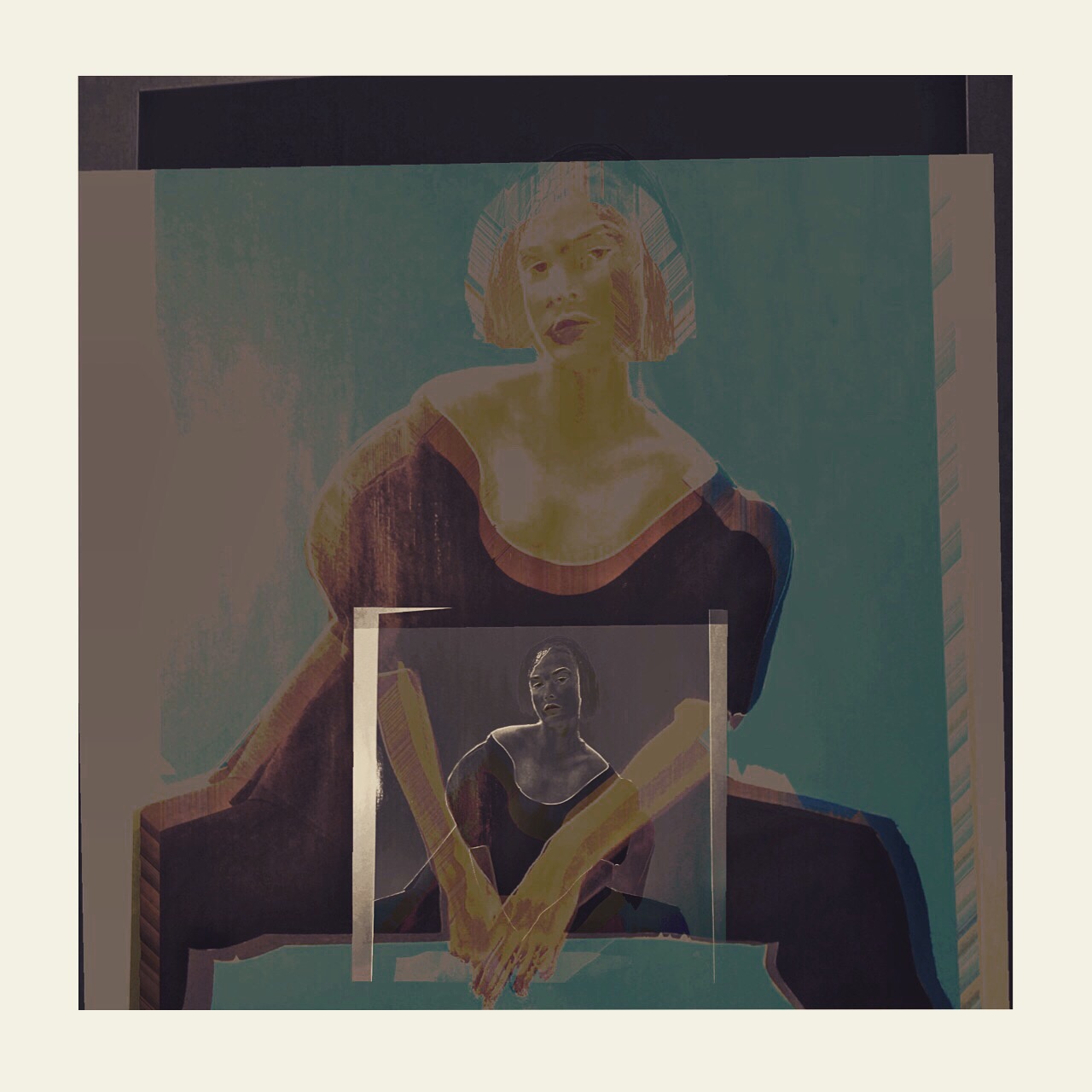
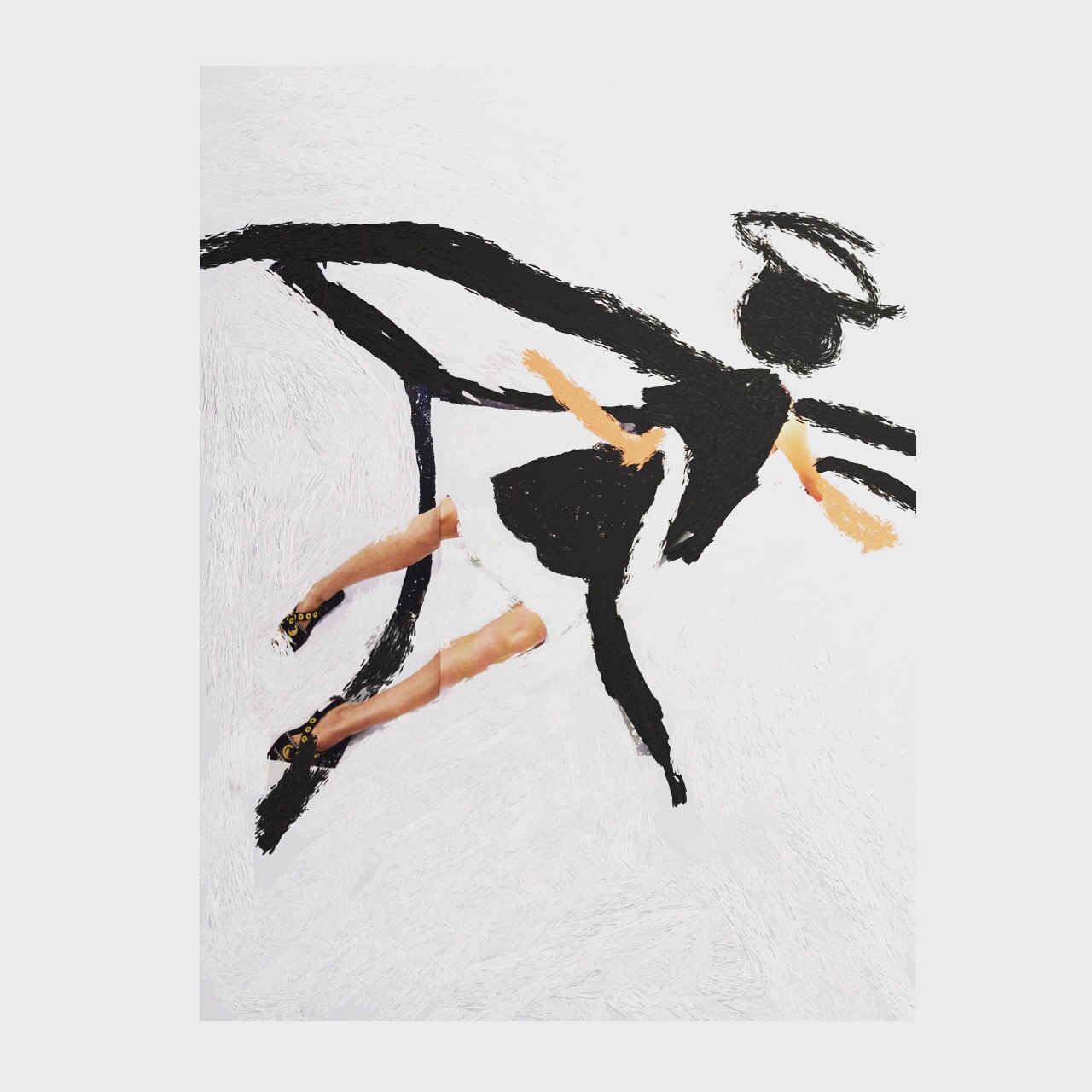
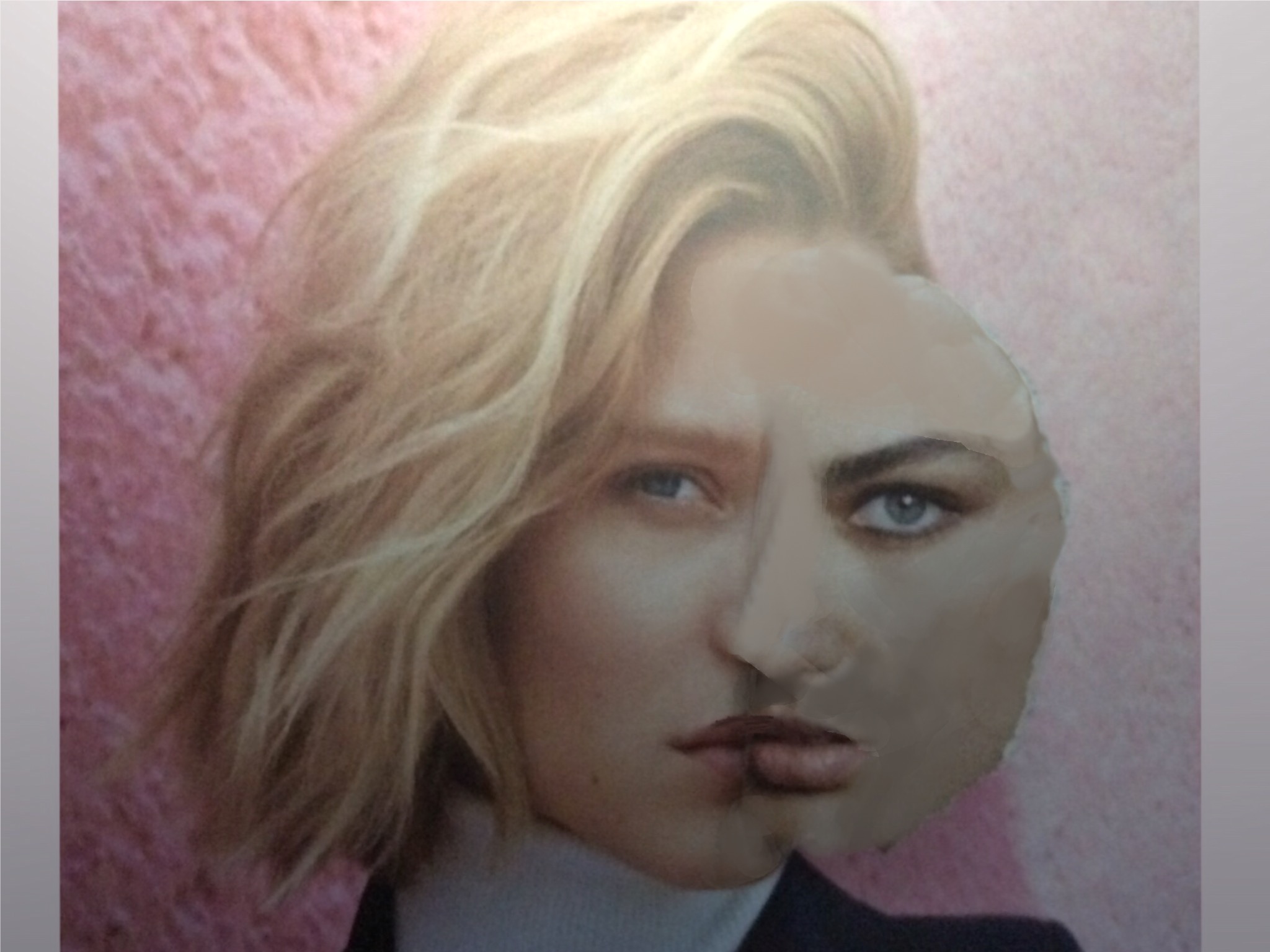


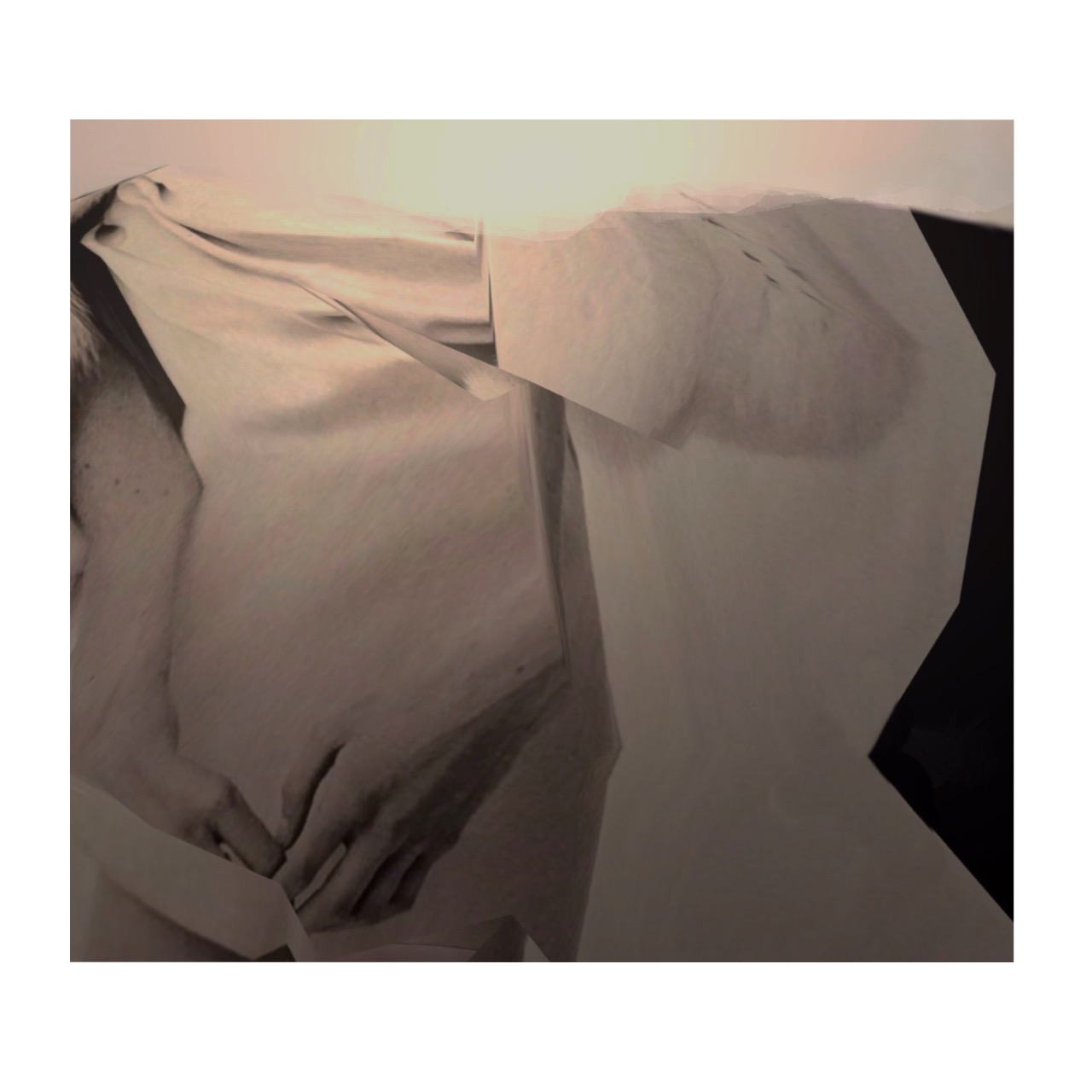
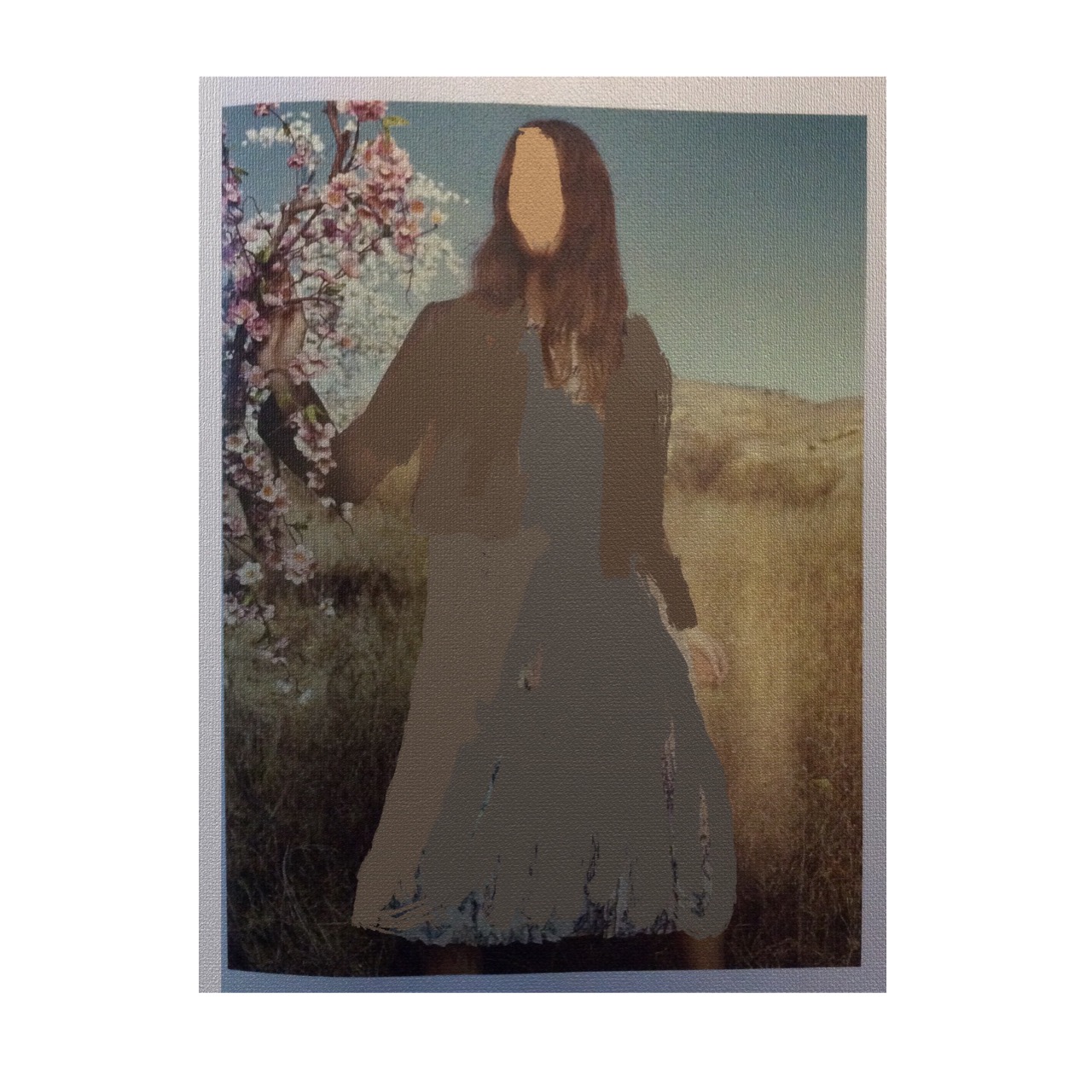
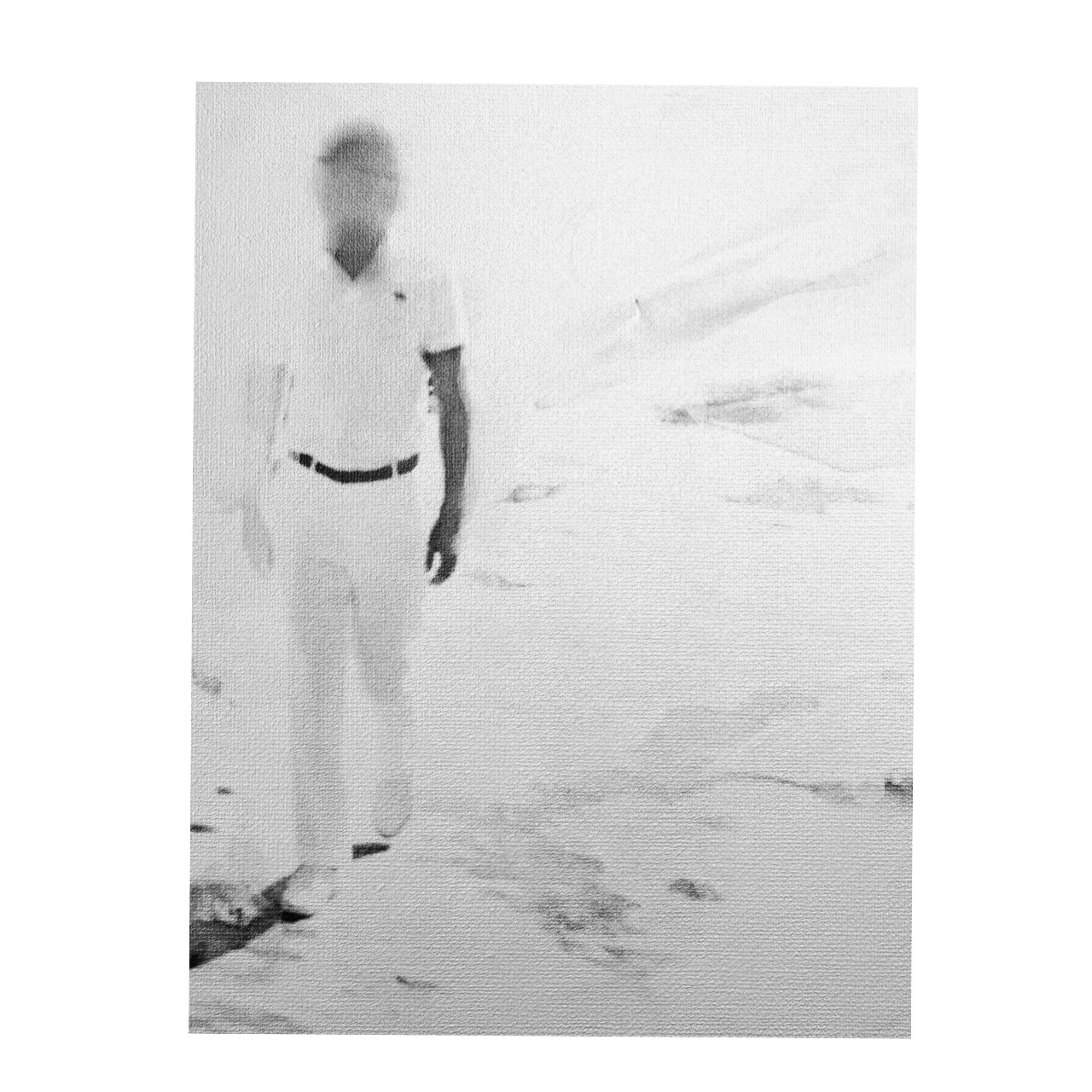
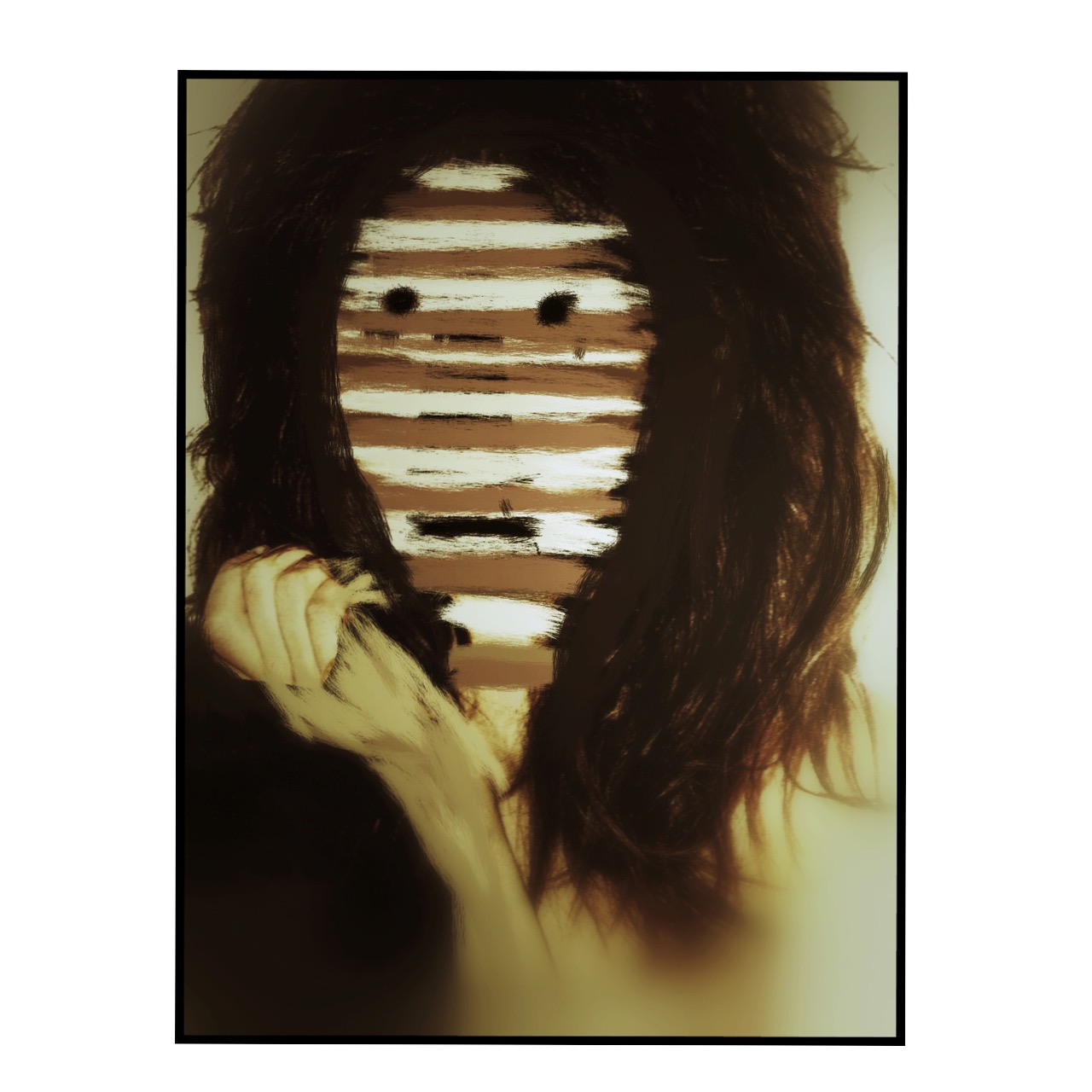

Tentoonstelling [Exhibition] #074 • John Hudak (USA) • Photo Collages • [https://bit.ly/3c6jLoq] • [instagram: possibility_pictures] • Juli 2022 • Galerie De Vijf Ramen • Sonsbeeksingel 150 • Arnhem, Nederland [a window gallery in Arnhem, The Netherlands]
John Hudak’s thematically-related grouping of untitled digital collages, pop-codex-based excavations, and altered digital images was not conceived as a cohesive body of work, and certainly not as an exploration or critique of visual tendencies still prevalent in the wake of so many others regarding the sphere of popular and high-art imagery, but for that reason alone – that it arises as a spontaneous, one might go so far as to say desultory and almost unconscious (if still highly-sensitized) response to commonplace artifacts of our visual environment – it merits serious attention.
Hudak’s source imagery, deriving from the domain of fashion photography and advertising, still retains the often-problematic visual allure of the “society” or glamour magazine, its aura at least, but now rendered inert, transparent, innocent, or self-aware by his implicitly analytical interventions. The female “object” recovers her depth, complexity, and subjectivity – her resistance, her hesitancy, her non serviam, even her ordinariness – beneath these delicate, indeed conscientiously modest ministrations.
Already in focusing on the face, the disadvantage of the object (or the advantage of the nominal provocateuse) of desire is reduced and the covetous gaze thwarted by the fact that an actual person must be reckoned with. But Hudak configures the actual person as fugitive, as deformed or wounded by crude appraisal, uneasy under scrutiny, sheepish in her complicity or in flight from its unintended consequences. These images resist the gaze, blurring, fluttering, occluding, deflecting, labile, evanescing; they are metamorphoses, and often captured in mid-act.
Hudak’s agenda, and in the process of identifying a consistent tendency among his images it demands reconsideration as an agenda (and a body of work), is established in the piece from which the rest of the suite radiates, the art-historically suggestive black-and-white collage – the only one to include a male figure – that may be read as an allegory of the melancholy, indeed tragic dynamic of bare desire, nobler purpose, and squandered potential, Bernini’s Apollo and Daphne on the left, and a dejected, seemingly helpless Aphrodite of Milos, averting her face in putative dismay as if invoking Eve in a treatment of the Expulsion, of which she has been the inadvertent cause, on the right.
He sets a quieter stage for metamorphic drama with this sculptural mise-en-scène – echoing Bernini that art is the metamorphosis (and maybe the petrification) of experience – and indeed collage is the intrinsically metamorphic and perhaps therefore the emblematic art, nowadays radically transformed by the potentials of digital manipulation. As the agitated, terrified Daphne transmutes into the chaste, quiescent laurel – but imagine the agonies were such a reconfiguration actually possible – Hudak’s subjects elude the greedy eye through protean strategies of flight, concealment, disguise, or withdrawal.
They seem damaged or wary (and therefore meditative) objects of desire, silenced or silent by choice, made to listen rather than to speak – to ponder rather than to blather – blinded or veiled, shifting their gaze, keeping an eye on the exits, seeing things (and showing themselves) double, improvising alternatives, transmogrified, some Daphne, some Philomela, some Scheherazade. And it is good to recall that it was Apollo’s hubris – a god, no less – that inaugurated the whole travesty of love, the sermon of objectification and diminishment and self-debasement that the myth embodies, and that hubris back then meant not so much overweening pride as the “intentional use of violence to humiliate or degrade.”
And isn’t collage always about damage, the shattering and the repair of our innocent sense of unity, the engagement with inherent multiplicity, a viable Weltanschauung as mosaic or patchwork? It is a visual art for the post-Babel world, an ontology for a broken one – an always-already broken one – and not merely through sin and guilt, but the mere fact of individuality and difference, an epistemology for a world in which there is no intact original, no continuous field of experience, but rather conflicting and divergent purposes and interests that must somehow integrate and even cohere, the way we patch our selves together, in fact; an ethic for our troubled coexistence.
The patriarchal gaze is a two-edged sword. Even as it hews the image of the female to its narrow and shallower purposes, it creates the suspicion that there is much more to her than simply meets the eye. Precisely in limiting, diminishing, distorting, indeed truncating the human sphere of woman, it has always simultaneously propagated a mystique of the feminine, her unplumbable depths, the enigma of her silence, the grandeur of her sorrow, just what it might possibly be that she could want.
And Hudak, internationally known sound-artist, prevails upon this vast residue that the gaze has relegated to silence and made of woman its repository. The work is suffused with the profundity of silence and the richness of its character, the virtual futility of speech in the face of such arrant neglect and crass misunderstanding. But it is not polemical so much as aspirationally empathic…and curious, imagining that the shackles of habit, the hubris of word and concept, the resolute ignorance of prejudice may be as easily dissolved as they’ve been formed.
Hudak’s work is enigmatic, counter-verbal, resistant to particularities or specificities of meaning, even as it embraces the specificity of things, of sounds and images, often very modest sounds and images, and, as remarked, the weight, the value of silence. His are rich junctures of meaning that rebuff the impulse to pigeonhole them, insisting, like the multiple eyes or mouths in several of the present images, that there is always more, that a single way of seeing is as good as blindness, that the ultimate specificity of thing, or act, or image necessarily transcends, overwhelms the facile and inherently appropriative act of meaning; that meaning is both too little and too much in the face of the thing, and far more so of the subject.
If the patriarchal gaze has demeaned (and elevated) the subject as art, lost sight of its existential particularity and human complexity, it has also offered a key to its liberation, that mostly lost and even widely discredited art of seeing, in which John Hudak’s mediations and meditations are an object lesson.
John Wronoski • duck@lameduckbooks.com
July 2022












Tentoonstelling [Exhibition] #074 • John Hudak (USA) • Photo Collages • [https://bit.ly/3c6jLoq] • [instagram: possibility_pictures] • Juli 2022 • Galerie De Vijf Ramen • Sonsbeeksingel 150 • Arnhem, Nederland [a window gallery in Arnhem, The Netherlands]
John Hudak’s thematically-related grouping of untitled digital collages, pop-codex-based excavations, and altered digital images was not conceived as a cohesive body of work, and certainly not as an exploration or critique of visual tendencies still prevalent in the wake of so many others regarding the sphere of popular and high-art imagery, but for that reason alone – that it arises as a spontaneous, one might go so far as to say desultory and almost unconscious (if still highly-sensitized) response to commonplace artifacts of our visual environment – it merits serious attention.
Hudak’s source imagery, deriving from the domain of fashion photography and advertising, still retains the often-problematic visual allure of the “society” or glamour magazine, its aura at least, but now rendered inert, transparent, innocent, or self-aware by his implicitly analytical interventions. The female “object” recovers her depth, complexity, and subjectivity – her resistance, her hesitancy, her non serviam, even her ordinariness – beneath these delicate, indeed conscientiously modest ministrations.
Already in focusing on the face, the disadvantage of the object (or the advantage of the nominal provocateuse) of desire is reduced and the covetous gaze thwarted by the fact that an actual person must be reckoned with. But Hudak configures the actual person as fugitive, as deformed or wounded by crude appraisal, uneasy under scrutiny, sheepish in her complicity or in flight from its unintended consequences. These images resist the gaze, blurring, fluttering, occluding, deflecting, labile, evanescing; they are metamorphoses, and often captured in mid-act.
Hudak’s agenda, and in the process of identifying a consistent tendency among his images it demands reconsideration as an agenda (and a body of work), is established in the piece from which the rest of the suite radiates, the art-historically suggestive black-and-white collage – the only one to include a male figure – that may be read as an allegory of the melancholy, indeed tragic dynamic of bare desire, nobler purpose, and squandered potential, Bernini’s Apollo and Daphne on the left, and a dejected, seemingly helpless Aphrodite of Milos, averting her face in putative dismay as if invoking Eve in a treatment of the Expulsion, of which she has been the inadvertent cause, on the right.
He sets a quieter stage for metamorphic drama with this sculptural mise-en-scène – echoing Bernini that art is the metamorphosis (and maybe the petrification) of experience – and indeed collage is the intrinsically metamorphic and perhaps therefore the emblematic art, nowadays radically transformed by the potentials of digital manipulation. As the agitated, terrified Daphne transmutes into the chaste, quiescent laurel – but imagine the agonies were such a reconfiguration actually possible – Hudak’s subjects elude the greedy eye through protean strategies of flight, concealment, disguise, or withdrawal.
They seem damaged or wary (and therefore meditative) objects of desire, silenced or silent by choice, made to listen rather than to speak – to ponder rather than to blather – blinded or veiled, shifting their gaze, keeping an eye on the exits, seeing things (and showing themselves) double, improvising alternatives, transmogrified, some Daphne, some Philomela, some Scheherazade. And it is good to recall that it was Apollo’s hubris – a god, no less – that inaugurated the whole travesty of love, the sermon of objectification and diminishment and self-debasement that the myth embodies, and that hubris back then meant not so much overweening pride as the “intentional use of violence to humiliate or degrade.”
And isn’t collage always about damage, the shattering and the repair of our innocent sense of unity, the engagement with inherent multiplicity, a viable Weltanschauung as mosaic or patchwork? It is a visual art for the post-Babel world, an ontology for a broken one – an always-already broken one – and not merely through sin and guilt, but the mere fact of individuality and difference, an epistemology for a world in which there is no intact original, no continuous field of experience, but rather conflicting and divergent purposes and interests that must somehow integrate and even cohere, the way we patch our selves together, in fact; an ethic for our troubled coexistence.
The patriarchal gaze is a two-edged sword. Even as it hews the image of the female to its narrow and shallower purposes, it creates the suspicion that there is much more to her than simply meets the eye. Precisely in limiting, diminishing, distorting, indeed truncating the human sphere of woman, it has always simultaneously propagated a mystique of the feminine, her unplumbable depths, the enigma of her silence, the grandeur of her sorrow, just what it might possibly be that she could want.
And Hudak, internationally known sound-artist, prevails upon this vast residue that the gaze has relegated to silence and made of woman its repository. The work is suffused with the profundity of silence and the richness of its character, the virtual futility of speech in the face of such arrant neglect and crass misunderstanding. But it is not polemical so much as aspirationally empathic…and curious, imagining that the shackles of habit, the hubris of word and concept, the resolute ignorance of prejudice may be as easily dissolved as they’ve been formed.
Hudak’s work is enigmatic, counter-verbal, resistant to particularities or specificities of meaning, even as it embraces the specificity of things, of sounds and images, often very modest sounds and images, and, as remarked, the weight, the value of silence. His are rich junctures of meaning that rebuff the impulse to pigeonhole them, insisting, like the multiple eyes or mouths in several of the present images, that there is always more, that a single way of seeing is as good as blindness, that the ultimate specificity of thing, or act, or image necessarily transcends, overwhelms the facile and inherently appropriative act of meaning; that meaning is both too little and too much in the face of the thing, and far more so of the subject.
If the patriarchal gaze has demeaned (and elevated) the subject as art, lost sight of its existential particularity and human complexity, it has also offered a key to its liberation, that mostly lost and even widely discredited art of seeing, in which John Hudak’s mediations and meditations are an object lesson.
John Wronoski • duck@lameduckbooks.com
July 2022